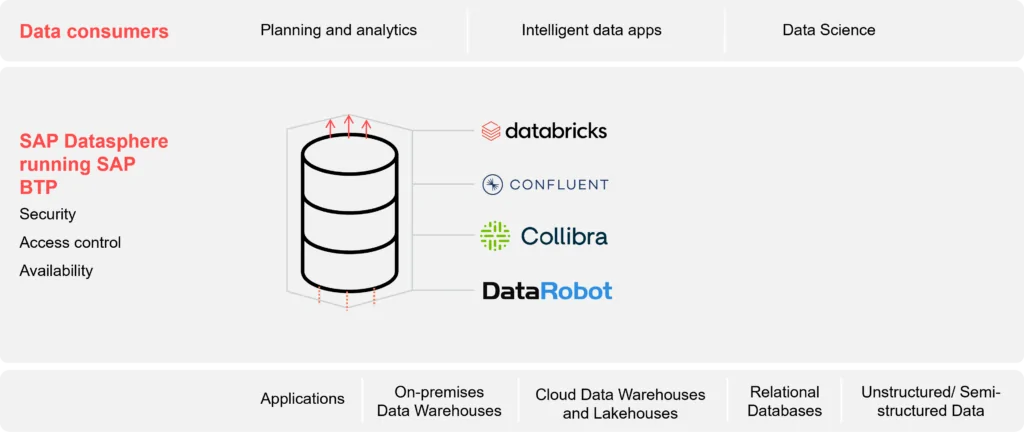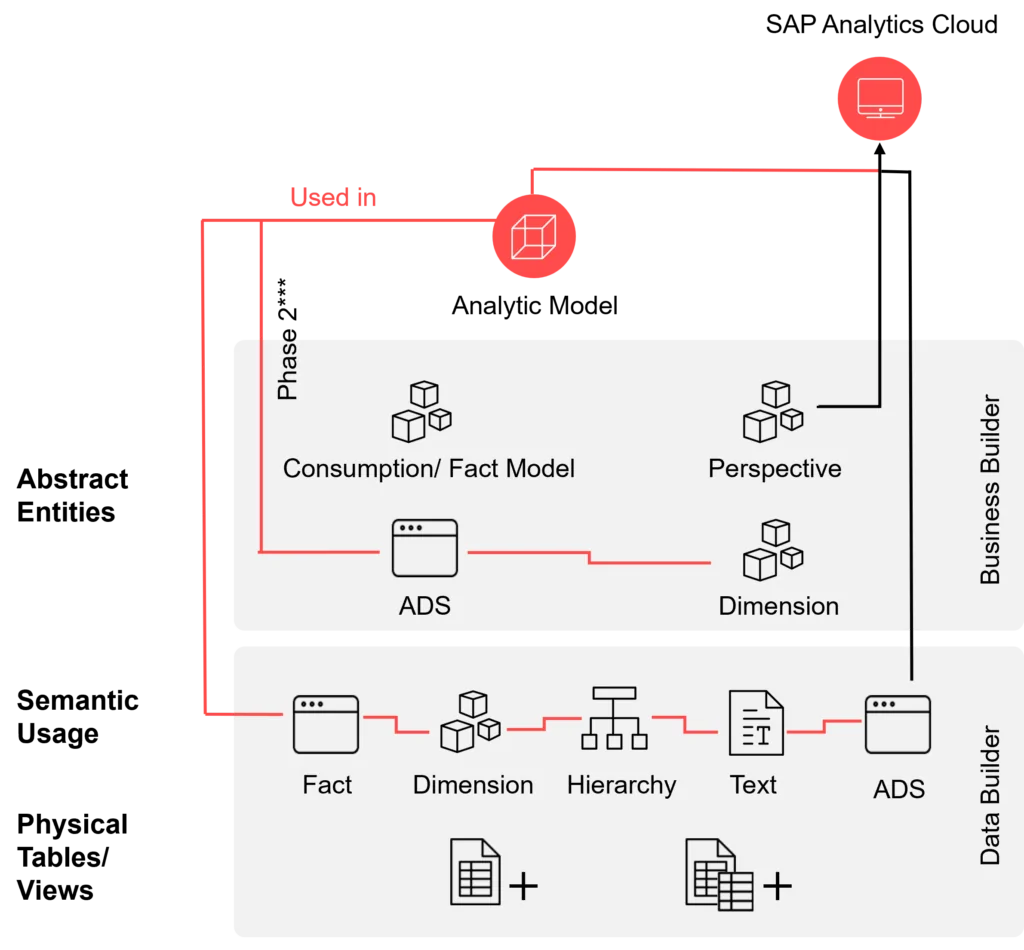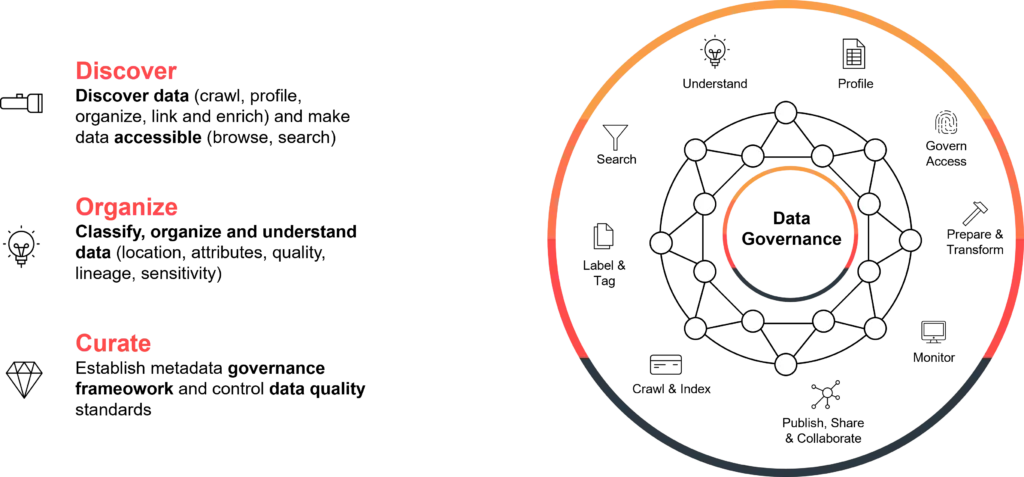The SAP Data Warehouse Cloud is now called the SAP Datasphere. With this change in Update 2023.6, SAP not only announced the renaming of its cloud data warehouse, but also released a number of innovations that will make the SAP Datasphere a data fabric in the future. Today, we’ll take a look at what has happened “under the hood” of the SAP Datasphere. We’ll focus on what we think are the most exciting and important innovations in the areas of data integration, data modeling, and data cataloging. We’ll also examine the partnerships and new alignment of the SAP Datasphere as a data fabric.
SAP Datasphere is now a data fabric
In addition to the public renaming to SAP Datasphere, the SAP Data Warehouse Cloud is no longer “just” a cloud data warehouse, but a data fabric. The term goes beyond the understanding of a data warehouse and describes a structure that provides a semantically rich data layer across all the underlying data landscapes, connecting different cloud and on-premise environments. The core of the idea is that the data does not necessarily have to be integrated from other systems; instead, access is mostly virtual.
The SAP Datasphere provides a comprehensive approach to implementing a data fabric thanks to its many options for data integration, data cataloging, semantic modeling, data warehousing, data federation, and data virtualization functions. The SAP Datasphere therefore gives you a tool that can capture and process the entire context of your company’s data.

Data integration
Replication flows have been added in the data integration area. These enable you to load multiple data assets from one source into a target. Sources include SAP HANA (Cloud) and SAP S/4HANA. This allows the SAP Datasphere to extract data from specific sources using delta logic and process simple mapping logics and projections during loading.
In addition, more BW bridge features have been rolled out, which make it possible to use InfoObjects with a write interface. This way, texts and attributes from the known master data types can now be moved to the incoming table using tools such as SAP Data Services and CPI.
Since update 2023.3, SAP Success Factors users have had the opportunity to benefit from the completely activated SAP Success Factors connection. This new connection type allows modelers in the SAP Datasphere to access all SAP Success Factors services, including the OData V4 API endpoints, even those that are not only used for analytical dashboards.
Data modeling
One highlight of release 2023.6 was the analysis model. It gives users another option for preparing data for use in the SAC. In this new data builder object type, it is now possible to create or define multi-dimensional models to provide data for analysis purposes. Pre-defined metrics, hierarchies, and associations enable easy navigation through the data; procedurally, this is very similar to the familiar SAP Analytics Cloud data analyzer. However, the data will still only be released via perspectives in the business layer or analytical datasets in the data layer for consumption in the SAP Analytics Cloud (it is currently possible to select the analytical model as the data source only in the optimized mode of the SAP Analytics Cloud).

In addition to the analysis models, other data modeling innovations were added, such as mass implementations for task chains and e-mail notifications about task chains.
Another point worth mentioning in our view, however, is the possibility that TCUR* tables can now also be shared across spaces. This means that the source for currency conversion views can now also be TCUR* tables already created from other spaces, provided they have been shared with the space in question. This eliminates the double overhead of creating the tables and the resulting redundancies in the SAP Datasphere.
Data cataloging
The newly introduced data catalog now gives users the opportunity to implement an effective data governance strategy. The catalog is a separate category on the context menu of the SAP Datasphere. The catalog is the central location for gathering information about data assets. This makes it possible to build up a comprehensive business dictionary. In the catalog, the tags, glossary terms, and KPIs created can then be linked to the various data assets. In addition, the catalog offers the option of extracting and recording metadata from other systems (SAP Datasphere or SAP Analytics Cloud). However, in order to use this functionality, separate connections to the systems must be established.
So that you can see and try out the new catalog, there are now two additional roles in the SAP Datasphere. The catalog administrator role allows users to set up and implement the catalog. The catalog user role allows users to search for assets and view them in full or use them as part of an asset.

Partnerships
SAP recently announced new partnerships with four data & AI companies: Databricks, Confluent, Collibra, and DataRobot.
The strategic partnerships that SAP enters into are of great interest to customers because they greatly increase the scope of functions outside the SAP Datasphere itself. The integration of machine learning by a third party is an innovation that may be of interest to many customers. Existing partners such as Adverity and Precog are good examples of how important partners are.
Outlook
For this year, there are other exciting innovations and improvements in the SAP Datasphere on the roadmap. Probably the most interesting innovation planned is the possibility that created artifacts of the business layer should be able to be transported between different tenants. This means that developments in a multi-system environment in the Business Builder would also be possible. In addition, business content for the SAP business layer should also be available this year.
In addition, the objects introduced will be enhanced, especially the data catalog. This will enable various backup and recovery options, as well as the linking of KPIs and terms to assets.
Looking further into the future, we recommend using the SAP Roadmap Explorer to stay informed about changes in the schedule and additional innovations in the SAP Datasphere.
We believe that SAP is taking the right step toward a data fabric with the innovations that it has already released for the SAP Datasphere 2023. The current detailed roadmap makes us look to the future with great interest.
We look forward to presenting the SAP Datasphere in detail. We’ll be glad to talk to you!
SAP Datasphere: The end-to-end warehouse in the cloud
Successful business decisions are now made easy thanks to our end-to-end management with the SAP Data Warehouse Cloud/SAP Datasphere.
Don't miss a thing.
Subscribe to our latest blog articles.